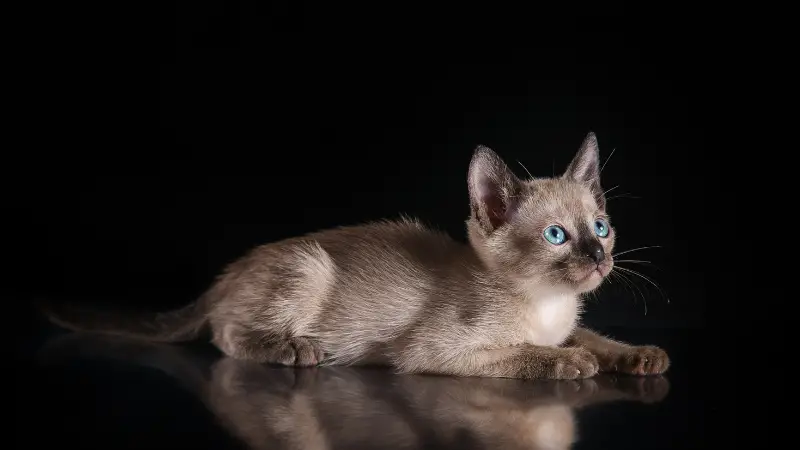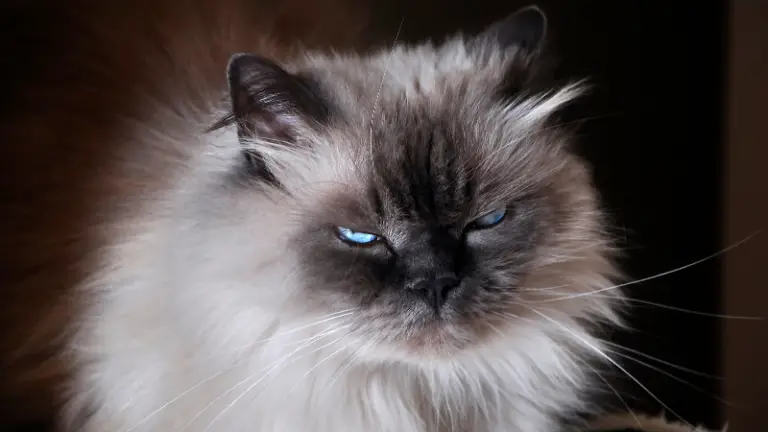TONKINESE CAT PERSONALITY AND BREED (ALL YOU NEED TO KNOW)
Do you want to know more about the Tonkinese cat personality? The colorpoint appearance of this cat reveals its close relationship with the Siamese; in fact, by temperament, he resembles him a lot.
Extroverted in nature, the Tonkinese cats are lively and boisterous; they crave attention and create a strong bond with people. At a glance, this cat has a lively and naughty nature, gets along well together with human beings, has a playful spirit, and has an easy-to-care coat.
Let’s explore the Tonkinese cat personality and breed.

WHAT IS THE TONKINESE CAT GENERAL ASPECT AND SIZE?
The Tonkinese cat combines the best characteristics of the Siamese and the Burmese. He inherited the well-proportioned and muscular body from the first cat and the second the colors.
The tail is rather long, should never be folded, and the colored ends are clearly visible, while the garment’s shape is more rounded and less triangular than the Siamese.
CHARACTERISTICS OF THE TONKINESE CAT:
| Characteristic | Description | Notes |
|---|---|---|
| In summary | Available in different colors and patterns | In North America it is described as a mink variant |
| Personality | Sociable and curious breed that requires a lot affection | |
| Appearance | It is actually a mixture of Siamese and Burmese, with particular water-colored eyes | |
| In the house | The playful nature requires a a lot of attention and games | It tends to have intermediate characteristics in all aspects |
| Behavior | He is not talkative like the Siamese | |
| Grooming | It is usually enough to stroke him regularly to remove almost detached hair | |
| Most common health problems | Vulnerable to respiratory infections | Single individuals can react poorly to anesthetics |
| Size | Medium-small from 1.5 to 5.5 kg | |
| Ears | Medium-large, broad at the base and rounded at the tip | |
| Head | Wedge-shaped, square muzzle and light nose, arched head with a slight stop | |
| Paws | Long-limbed; the rear ones are just longer than the previous ones | |
| Coat | Soft, shiny, and adherent to the body; the feel similar to silk. | |
| Admitted Colors | Natural seal, chocolate-champagne, lilac-platinum and blue |
▷ Color varieties are recognized in America, such as blue mink.
WHAT IS THE HISTORY OF THE TONKINESE CAT?
By definition, a breed must be “pure,” which means that the kittens must resemble their parents. Unfortunately, this is not the case with Tonkinese. On the contrary, it is possible that in the same litter are born specimens resembling the Siamese and the Burmese.
The confusion dates back to when these cats appeared for the first time in the West. Someone suggested that the first chocolate Siamese brought to Europe in the 1880s was a Burmese, and breed records relating to Wong Mau definitively confirm that it was a Tonkinese and not a Pure Burmese.
Later, however, the breeders concentrated on reproducing a darker variant, the Burmese one, so the Tonkinese characteristics were lost.
Later the breed was recreated in Canada with a cross between the Burmese and the Siamese but still remains a somewhat controversial example today. The coat is very particular, similar to that of mink.
The color of the body is darker than the corresponding Siamese variety and matches the colored ends; it tends to darken with age. As for temperament, the Tonkinese is not as demanding as the Siamese but rather prove themselves noisy. However, they generally get along well with each other.
THE ORIGIN OF THE TONKINESE CAT
As is the case with many other breeds from the oriental aspect and selected from the man, even for the Tonkinese cat, the name is not the country identifier of provenance, despite the assonance with the Chinese region of Tonkin and with the homonymous gulf.
Born in the United States starting in the early 60s of the twentieth century, this breed was selected by Jane Barletta, a New Jersey breeder who crossed a Siamese seal point with a Burmese sable.
With the Canadian colleague Margaret Conroy, Jane Barletta began a selective program using the subjects born from these first crossings to stabilize a definitive standard.
The name “Tonkinese” was a choice to emphasize this breed’s exotic look, which obtained official recognition in 1979 by the TICA. Unfortunately, despite a series of researches, the breed Tonkinese, although very widespread in the United States, is still relatively rare in Europe.
TONKINESE CAT PERSONALITY

From a character point of view, the Tonkinese inherited the best from the Siamese and the Burmese. This cat is highly friendly with other animals and also with humans. He is very attached to his family, with whom he loves spending time playing.
In fact, he can’t stand being alone but greatly enjoy the company, especially that of the children with whom they like to spend time. He also wants to “have a conversation” with his family, even if he is not talkative like his Siamese cousin.
Very intelligent, he learns easily how to open doors and branches. The sweet character of the Tonkinese makes it perfect for pet therapy.
The Tonkinese is one of the breeds that suffer more from loneliness.
Due to his extraordinary intelligence, and friendly and affectionate character, the Tonkinese often appears more similar to a dog than a cat. This breed, in fact, quickly learns many tricks, which sometimes seem to be staged on purpose to entertain the whole family.
If taught from an early age to be called by name, he will run quickly, and if he is taught to bring back small objects, he will have fun for hours getting the toy thrown.
Another characteristic of the Tonkinese (almost prodigious) is that he tends to teach the little ones the games he has learned from his masters. But, playful as it is, the Tonkinese could turn out an annoying companion for quieter cats: it is better to give him a friend equally lively.
HOW TO CARE FOR AND FEED THE TONKINESE CAT
Robust short-haired cat, the Tonkinese requires very little and simple care. A
horsehair glove or deerskin used once a week is ideal to guarantee him an always shiny coat.
You could trim the nails if the cat did not manage to do it sufficiently well by himself using the scratching post. In both cases, the work must be carried out carefully and delicately, especially so as not to hurt the animal by shortening the nails.
Contrary to other cats who often change their menu, the Tonkinese is habitual in terms of food, so his ideal diet must always be based on the same type of food, preferably finished and of first quality. Possible changes to the diet must be made gradually,
The Tonkinese has a rather delicate intestine; therefore, feeding him food that comes from the table of humans is strictly prohibited.
FREQUENTLY ASKED QUESTIONS
What is the Tonkinese cat price?
A Tonkinese cat can cost as low as $75 and as high as $1500. The price depends on the breeder, age, and the breed’s purity.
What is the Tonkinese cat lifespan?
The Tonkinese cat can live up to 18 years. If you take care well of this cat, especially if you make him follow a diet that includes high-quality food, you can make him live a better and longer life.
What are the Tonkinese cat health problems?
The most common health problem for Tonkinese cats is the vulnerability to respiratory infections. They can get asthma, allergy, and other similar illnesses.
Do Tonkinese cats like to be held?
Tonkinese cats are very affectionate and intelligent, and they like to have affection from their owner and like to be held. Those cats do not like to be left alone and enjoy the company of others.
Do Tonkinese cats like to cuddle?
Tonkinese cats like to cuddle and interact with humans. They are affectionate and will come for their daily dose of cuddles.
Do Tonkinese cats meow a lot?
Tonkinese cats meow a lot and like to have “conversations” with their humans. They take this characteristic from their Siamese side.
Are Tonkinese cats intelligent?
Tonkinese cats are brilliant and can be trained to do tricks, open doors, fetch things, and more. They are so bright that if they have kittens, they can teach the kittens the tricks they know.







